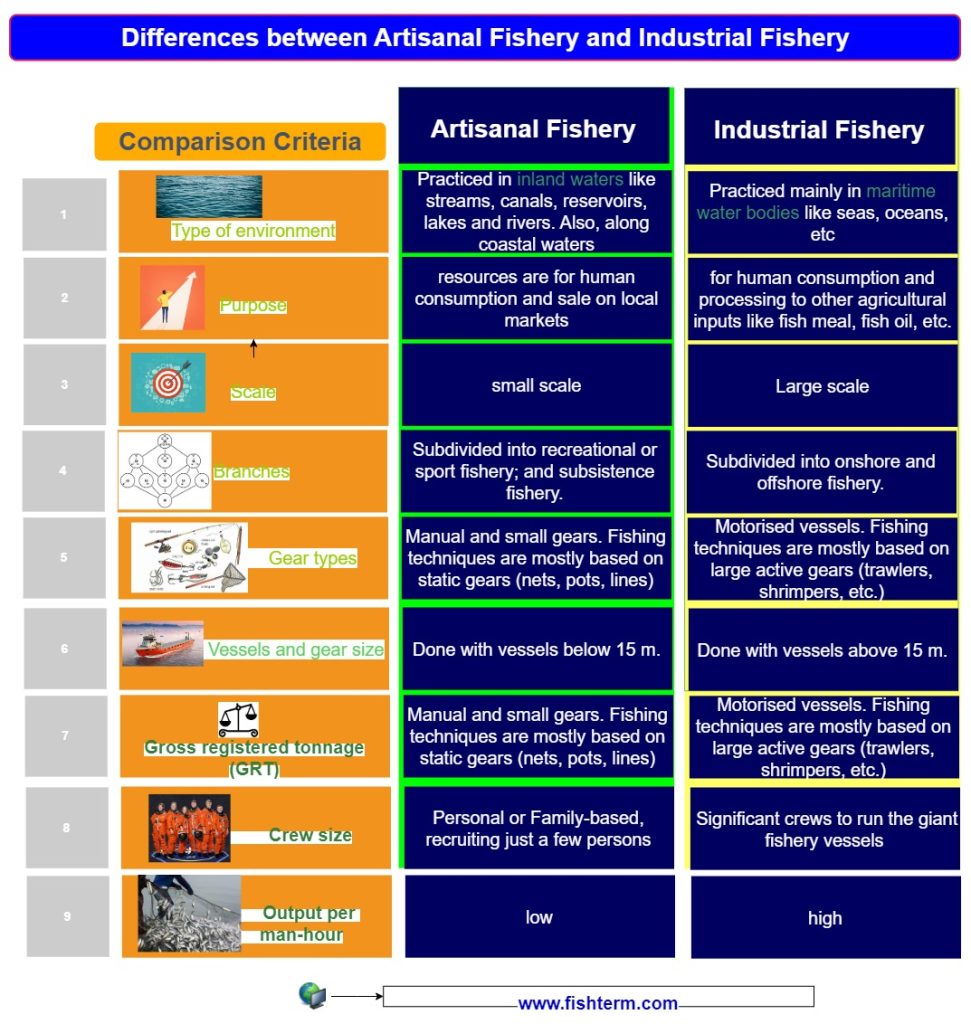Artisanal fishery vs Industrial fishery

Characteristics of Artisanal Fishery
- Artisanal fishery is rearing fish in inland waters like streams, canals, reservoirs, lakes and rivers.
- Artisanal fishery is mainly subsistence, and the fish are cultured or captured for human consumption only in rare cases are excesses processed as inputs or feed for other agricultural sectors.
- Other fishery types sometimes closely related to artisanal fisheries are subsistence fishery, traditional fishery, recreational fishery, and small-scale fishery.
- Artisanal fishery is often done on a small scale. This implies lower fishing effort, lower input, small capital, and little or no paid labour force.
- Gears used in artisanal fisheries are mostly manual and small. The fishing techniques are mostly based on static gears (nets, pots, lines) and especially at the human level e.g., fishing hooks and lines, pots, cast nets, and seines; vessels include canoes, engine boats, etc.
- Based on profit, artisanal fishery is subdivided into two types: recreational or sport fishery; and subsistence fishery.
- Most countries define this fishery type by vessel size with vessels below 15 m. Typically ranging from 5 to 15 meters.
- Another peculiarity is that an artisanal fisherman has his boat and works on it (if he owns two boats, just one is at sea at any given time).
- Artisanal fishery is carried out by stakeholders who have a strong local presence. Most artisanal fishers of a country are citizens and residents of that country
- Artisanal fishery is done within seven nautical miles offshore.
- Artisanal boats have a gross registered tonnage (GRT) of less than 10 tonnes. e.g. in Ghana, the GRT of a trawler and a shrimper should not exceed 300 and 200 respectively.
- Artisanal fisheries don’t rely on the use of large fishing vessels and significant crews to get their job done.
Let us combine all the above characteristics to define artisanal fishery in a sentence: artisanal fishery is a small-scale traditional fishery, mostly inland or coastal, fishing techniques mostly based on static gears (nets, pots, lines) and especially at the human level (the shipowner working onboard) with a strong local presence.
Characteristics of Industrial Fishery
- Industrial fishery is practised in maritime water bodies like seas, oceans, etc
- Industrial fishery resources cultured or captured are for human consumption and processing to other agricultural inputs like fish meal, fish oil, etc.
- It is a large-scale
- It uses heavy motorised vessels. Fishing techniques are mostly based on large active gears (trawlers, shrimpers, etc.)
- Industrial fishery is subdivided into onshore and offshore fisheries.
- Industrial fishery is typically done with vessels above 15 m.
- Residency of stakeholders may be partly international
- Above 100 GRT and varies by country and species exploited.
- Uses significant crews to run the giant fishery vessels and gear
Definition of industrial fishery: a large-scale fishery whose techniques are mostly based on large active gears, with vessels (trawlers, shrimpers, etc.) above 15 m and above 100 GRT, having significant crews on board mostly practised in maritime water bodies like seas, oceans, etc.
Differences between Artisanal fishery and Industrial fishery
Let’s look at the key differences between Artisanal fishery and Industrial fishery in the table below.
Table: Differences between Artisanal fishery and Industrial fishery
Comparison criteria |
Artisanal fishery | Industrial fishery | |
| 1 | Aquatic environment | Practiced in inland waters like streams, canals, reservoirs, lakes and rivers. In marine waters, it is done along coastal waters (onshore fishery) | Practiced mainly in maritime water bodies like seas, oceans, etc. Especially offshore. |
| 2 | Purpose of resources | resources cultured or captured are for human consumption and sale on local markets – in rare cases are excesses processed | resources cultured or captured are for human consumption and processing to other agricultural inputs like fish meal, fish oil, etc. |
| 3 | Scale | small scale | large scale |
| 4 | Gear type | Manual and small gears. Fishing techniques are mostly based on static gears (nets, pots, lines) | Motorised vessels. Fishing techniques are mostly based on large active gears (trawlers, shrimpers, etc.) |
| 5 | Sub-sectors | Subdivided into recreational or sport fishery; and subsistence fishery. | Subdivided into onshore and offshore fishery. |
| 6 | Vessel size | Done with vessels below 15 m. Dugout canoes and paddles with material made of wood. | Done with vessels above 15 m. Vessels made of fibreglass, steel, or quality timber |
| 7 | Residence of stakeholders | often local | Mostly international |
| 8 | Gross registered tonnage (GRT) | less than 10 tonnes | above 100 GRT and varies by country and species exploited. |
| 9 | Crew size | Personal or Family-based, recruiting just a few persons | Significant crews to run the giant fishery vessels |
| 10 | Environmental impact | Little or no impact on the environment | Often has a high impact on the environment when unregulated |
| 11 | Conservation method | Salting, smoking, sun-drying | Canning, freezing, icing |
| 12 | Fishing campaign (frequency of activity) | Daily | More than 30 days |
| 13 | Output per man-hour | Low | High |
Conclusion
The differences and similarities between the concepts mentioned above cover just the basics. Consult related posts drafted solely on artisanal or industrial fishery types, to obtain more information. Kindly drop more differences in the comment section below.
Leave a Reply